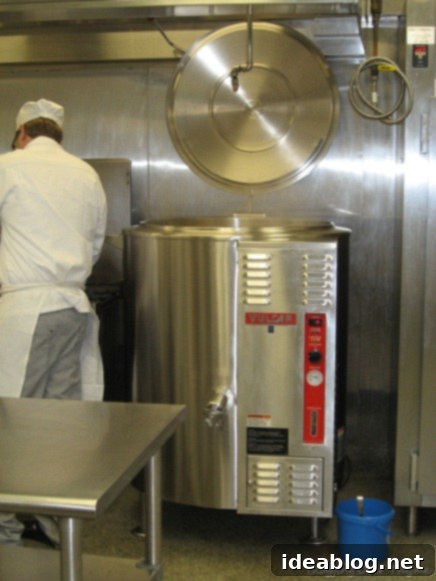Culinary School Day 2: Mastering French Classics – Stock, Quiche Lorraine, and Pate Brisee Foundations
Day two at culinary school commenced even earlier than the first, setting a brisk pace for the week ahead. Arriving around 6:10 am, I quickly changed into my chef’s uniform and headed straight to the bustling kitchen. Our primary task for the morning, as recommended by Chef Brian, was to embark on the crucial process of making chicken stock. This foundational element of French cuisine required meticulous preparation, utilizing a substantial 100 pounds of chicken backs, expertly trimmed the previous day, alongside numerous tubs of leftover mirepoix – a classic aromatic base of onions, carrots, and celery – all submerged in copious amounts of cold water. To truly grasp the immense scale of this operation, which involved colossal cooking equipment, the following image provides a clear visual:
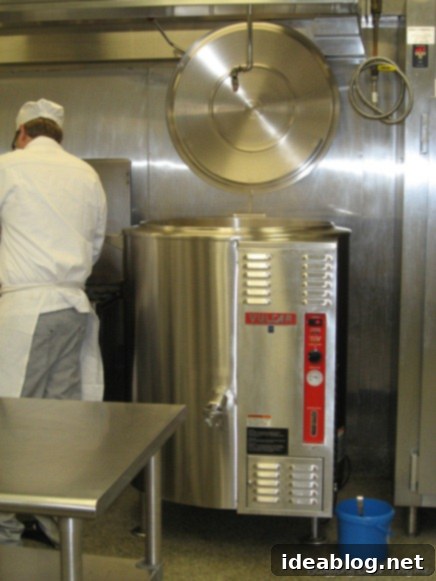
Throughout Phase I of our program, each student will gain hands-on experience by taking charge of stock preparation at various points. The ultimate goal for a high-quality stock is to minimize fat content, which is precisely why we dedicated time to thoroughly trim the chicken bones beforehand. Once assembled, the stock undergoes a slow, gentle simmer for hours, often extending into days, before it’s fully utilized, and the entire production cycle begins anew. The large hose visible in the top right of the image is used to efficiently fill the monumental stockpot with water, while the spigot at the bottom serves to dispense the finished stock into large tubs for subsequent culinary applications. It’s a truly impressive and somewhat peculiar setup to witness in person.
Adding to the morning’s busy schedule, another classmate and I were assigned the task of grating an enormous quantity of Gruyere cheese – easily accumulating at least 20 cups. The reason for this significant amount would become clear later in the day’s lessons, highlighting the ingredient’s versatility in classic French dishes.
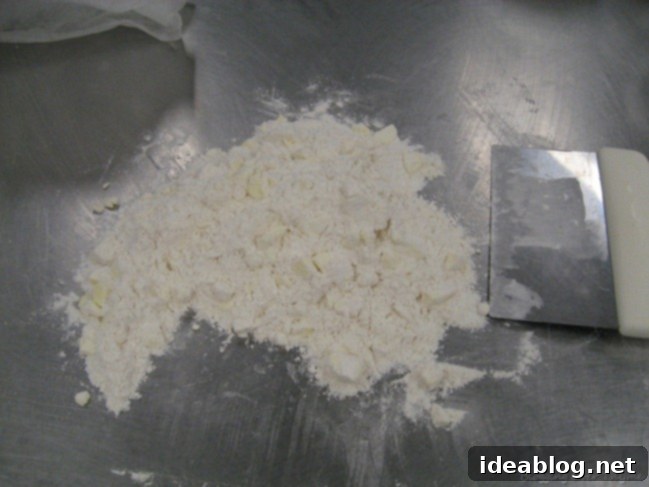
The Art of French Pastry: Mastering Pate Brisee
After the initial kitchen setup, our first formal lesson commenced with Chef Brian’s expert demonstration. The focus of this session was Pate Brisee, often translated as “broken dough.” This fundamental French pastry dough is unsweetened, characterized by its flaky texture, and commonly used for savory applications such as quiches or pie crusts. Today’s specific objective was to prepare it for a classic Quiche Lorraine, an iconic French quiche originating from the Lorraine region, traditionally featuring a rich blend of ham, bacon, and, of course, Gruyere cheese. It’s becoming evident that our daily culinary school lunches are gradually increasing in richness and flavor profile as we delve deeper into classic French techniques!
Pate Brisee is a cornerstone of French pastry, surprisingly simple yet requiring precision. It consists of only four essential ingredients: very cold unsalted butter, all-purpose flour, salt, and ice water. The process began with meticulously weighing out all ingredients. We then worked on our stainless steel worktables, using a bench scraper to carefully incorporate the cold butter into the flour and salt mixture. The key here is to break the butter into small, pea-sized pieces, avoiding overworking it into a fine, cornmeal-like consistency. This technique ensures that pockets of butter remain, which will later steam in the oven, creating distinct layers and a wonderfully flaky texture. Gradually, ice water was added, just enough for the dough to come together, remaining on the drier side and maintaining its signature “broken” appearance – hence the name. The magic of Pate Brisee lies in the contrast: the water content in the butter creates steam, lifting the pastry, while the fat simultaneously “fries” the dough, contributing to its tender crispness. Once formed, our dough was wrapped and refrigerated for a crucial hour. This chilling period allows the gluten to relax, preventing the dough from cracking or shrinking excessively during the subsequent rolling process, ensuring a perfect crust.
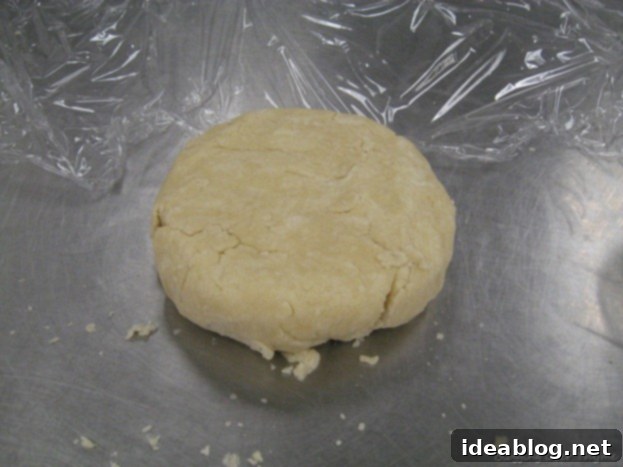
Lecture and the Day’s Comprehensive Menu
With our Pate Brisee dough resting, we transitioned from the kitchen to the classroom for another informative lecture and demonstration by Chef Brian, outlining the remainder of the day’s ambitious menu. Unlike yesterday’s relatively straightforward focus on French onion soup and a raw vegetable appetizer, today’s culinary journey promised a more extensive array of dishes, signaling an increased intensity in our curriculum. The full menu for the day included:
- LA SOUPE A L’OIGNON GRATINEE (French Onion Soup Gratinee)
- LA QUICHE LORRAINE (Quiche Lorraine)
- LA SALADE VERTE (Green Salad)
- LA SALADE DE CONCOMBRES ET TOMATOES (Tomato & Cucumber Salad)
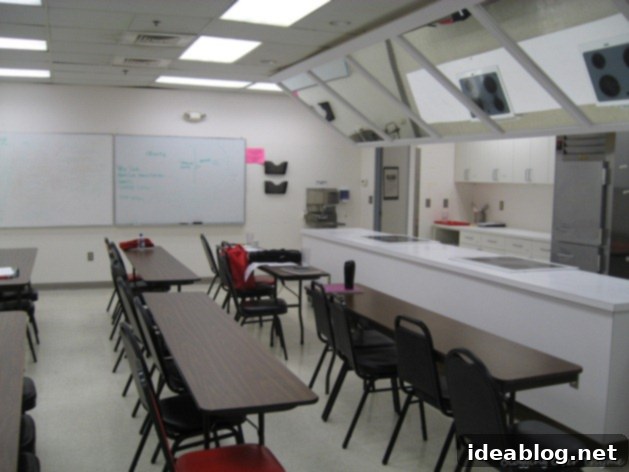
Unquestionably, the most time-consuming dishes on the menu were the Quiche Lorraine and, notably, a repeat of the French Onion Soup. This time, however, the soup would be elevated with the classic additions of crispy croutons and melted Gruyere cheese. While practicing the same dish might seem redundant, it serves a critical pedagogical purpose. Chef Brian explained that Phase I of our program emphasizes repetition to instill fundamental skills, allowing us to practice techniques multiple times, rectify previous mistakes, and build familiarity. In the case of French Onion Soup, this repetition is vital for mastering the intricate process of caramelizing onions. This involves repeatedly caramelizing and deglazing the onions until they develop a deep, dark color and a complex flavor profile that balances bitter, sour, and sweet notes – a true hallmark of an exceptional French Onion Soup.
Crafting Vinaigrettes: The Art of Emulsification
For the green salad and the tomato & cucumber salad, we learned to prepare a classic French vinaigrette. This essential dressing typically comprises sherry vinegar, finely minced shallots, garlic, a blend of extra virgin olive and canola oils, and a touch of Dijon mustard. The technique demands a delicate balance of control and continuous motion: holding a mixing bowl securely in one hand, while steadily pouring in the oil with the other, all while whisking vigorously and constantly. This continuous whisking is crucial to achieve proper emulsification, preventing the oil and vinegar from separating and ensuring a smooth, cohesive dressing.
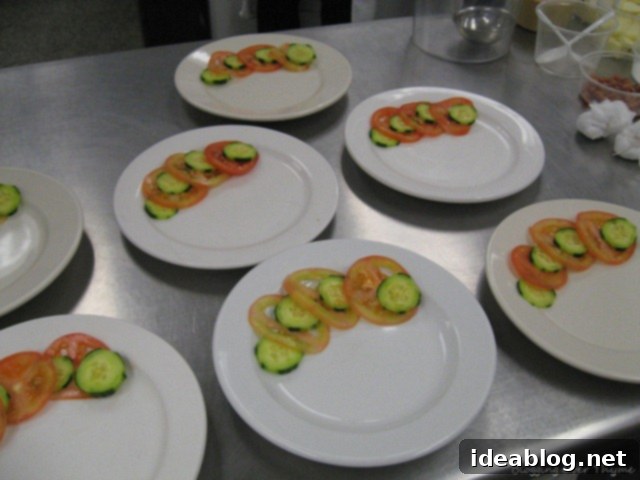
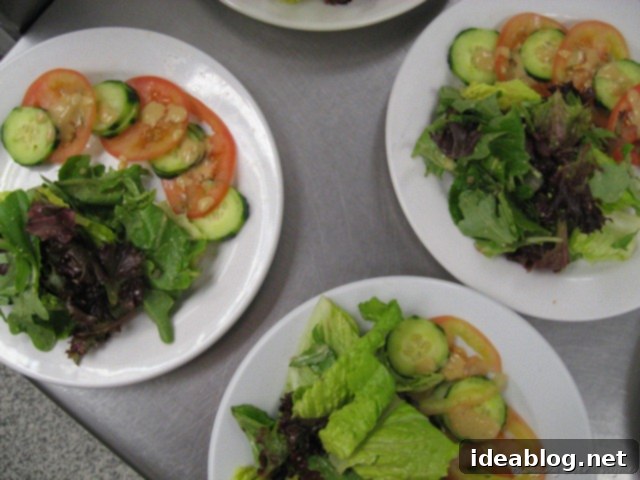
During these invaluable demonstrations, we are expected to pay close attention not only to the chef’s preparation of each dish but also to the exact order of plating. This is because we are tasked with recreating these dishes in the kitchen, following the same sequence precisely. A challenging yet increasingly appreciated aspect of this training is that the chefs rarely provide exact quantities of ingredients. Instead, they offer vague quantities or, if appropriate, specific ratios. For instance, for our vinaigrette, we weren’t given precise measurements for vinegar or oil but rather instructed to use a ratio of 1 part vinegar to 3 parts oil (split evenly between canola and olive oil). L’Academie rigorously stresses this approach, as it prepares us to adapt to varying serving sizes and quantities in a professional kitchen environment. This method also hones our sensory judgment – learning to cook by taste, sight, sound, and aroma – rather than solely relying on a written recipe. It encourages creativity and adaptability, skills I am eager to develop.
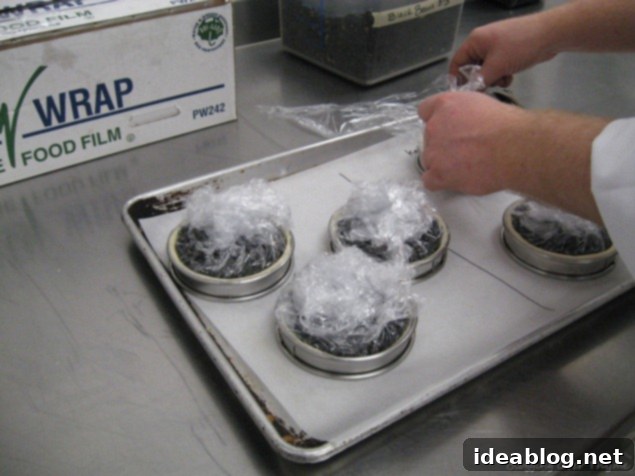
Kitchen Production: From Dough to Plated Masterpiece
Following the comprehensive demonstrations of each menu item, we returned to the kitchen for the practical production phase. Our first order of business was to retrieve the Pate Brisee dough from the refrigerator. We then rolled it out with precision, gently placed it into tart molds, and carefully pierced the bottom with forks to prevent it from puffing up excessively during baking. This was followed by blind-baking, a crucial step that involves partially or fully baking the crust before adding the filling (approximately 90-100% completion). To maintain the crust’s shape during this process, we used dry beans as weights. A critical safety note learned today: we lined our crusts with commercial kitchen-grade plastic wrap, designed to withstand high heat. This is distinct from household saran wrap, which would melt, so it’s imperative not to attempt this at home! For home baking, parchment paper or, as we learned, even coffee filters, are suitable alternatives.
We were then assigned to various work tables and station partners. While the final plating of dishes is a collaborative team effort, each student ultimately contributes to every component of the meal at some point, fostering a comprehensive learning experience.
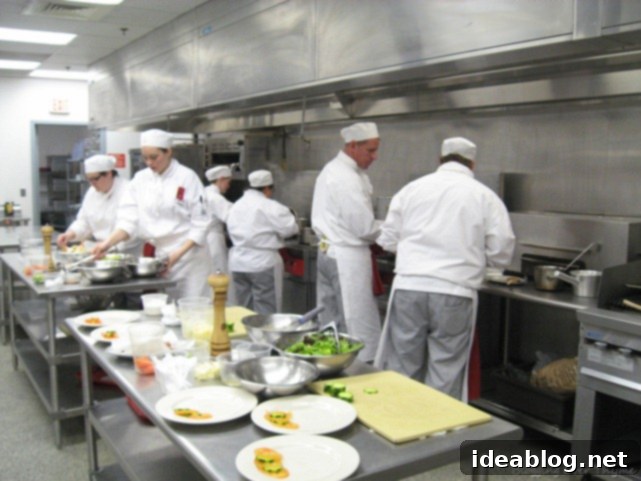
Constructing the Perfect Quiche Lorraine
Next, we diligently set to work on preparing the French Onion Soup (once again, refining our skills!), assembling the salads with our freshly made vinaigrette, and meticulously getting the custard ready for the Quiche Lorraine. In our lecture, we had learned that a classic quiche is composed of three essential elements:
- Filling: In this instance, a delightful mix of diced ham and bacon.
- Custard: A specific ratio of 1 cup heavy cream to 2 whole eggs, creating a rich, tender base.
- Crust: Our meticulously prepared Pate Brisee.
The custard mixture was gently whisked, seasoned perfectly with salt, pepper, and a touch of nutmeg, then strained to ensure a silky-smooth texture, free of any lumps. Once the custard was ready, I focused on cooking the finely cubed bacon until crisp, then used its rendered fat to cook the ham, effectively removing any excess moisture. This step is crucial to prevent the quiche from becoming watery. By this point, our tart shells had been blind-baked to perfection. We then sprinkled a small amount of grated Gruyere cheese over the base, followed by a layer of the cooked bacon and ham, and finally, carefully poured in the prepared custard. The quiche was then baked for another 15-20 minutes in a convection oven set to a very low heat (275-300°F). The goal is to cook the custard until it holds its shape yet still retains a delicate “jiggle” in the center, indicating a perfectly set, creamy texture.
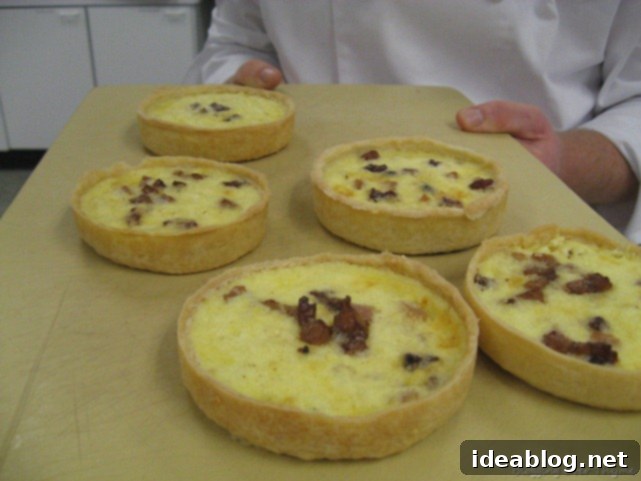
As we learned today, the principle behind cooking protein at a lower temperature is vital: proteins, such as eggs in our quiche, remain tender, retaining more fat and moisture. Conversely, cooking proteins too quickly at high temperatures causes them to constrict, expelling fat and water, resulting in a tough, dry texture. This scientific understanding underpins many of the techniques we are mastering.
Perfecting French Onion Soup Gratinee
Our final dish to prepare was another rendition of the delicious French Onion Soup, this time topped with a substantial crouton (defined as perfectly dry toast) and a generous layer of grated Gruyere cheese. The technique involves carefully placing the crouton directly on top of the hot soup just before it goes under the broiler, then smothering it completely with a hefty amount of cheese. This entire assembly is then placed under the broiler until the cheese melts into a golden, bubbly crust and browns lightly. The term “Gratinee” itself simply means to brown on top, and achieving that perfect golden crust is a mark of a well-executed French Onion Soup.
The entire process was not only incredibly educational but also resulted in truly delicious outcomes.
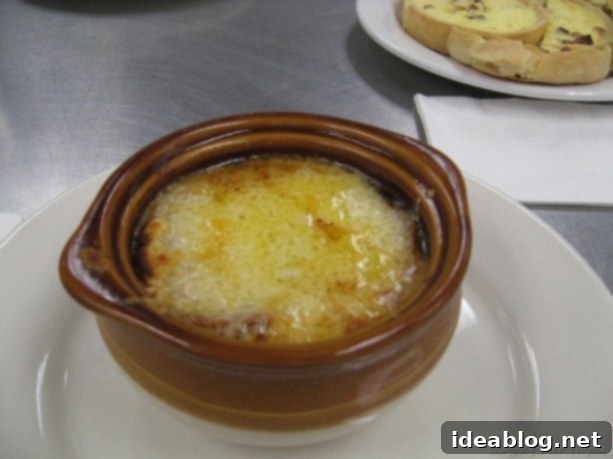
The Rigors of Kitchen Cleanup: An Essential Culinary Skill
Once all our dishes were meticulously plated, served, and enjoyed, we transitioned to the daily and equally critical task of cleaning the kitchen from top to bottom. When I say “top to bottom,” I genuinely mean every single surface and piece of equipment. My assigned table, along with two others, was responsible for the thorough cleaning of the entire kitchen. This exhaustive process includes sweeping, mopping, and sanitizing all stainless steel surfaces, as well as individually scrubbing each gas burner to ensure pristine cleanliness.
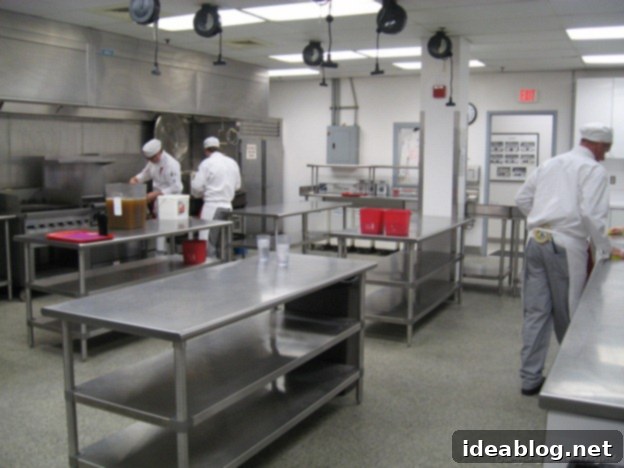
Beyond cleaning surfaces, we are also responsible for emptying all trash. As luck would have it, my assignment today included the rather unpleasant task of disposing of all the “gunk” – a somewhat crude but accurate term for the cooked bones and vegetable bits that had been drained from the massive batch of chicken stock we started earlier. This waste weighed an absolute ton! A fellow student, Tasha, and I were tasked with removing this heavy, cumbersome material and taking it out to the dumpster. Despite our combined efforts, lifting it into the dumpster proved to be a significant struggle, truly testing our strength.
While this is undoubtedly my least favorite part of the day, I can already sense a growing efficiency within our class. We are all slowly but surely figuring out the layout of the kitchen, the location of cleaning supplies, and the most effective procedures. It still requires numerous reminders and questions, but the progress is noticeable, reflecting the collective effort to master every aspect of professional kitchen operations.
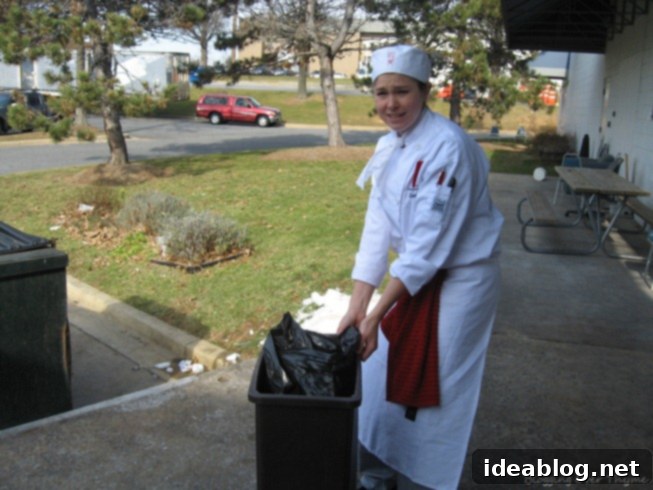
The Core of Our Learning: Recipe Notebooks
The final hour and a half of our day was spent back in the classroom, delving into the critical importance of our recipe notebooks. These notebooks are not mere organizational tools; they constitute the largest component of our overall grade throughout the culinary program. The director of the academy personally reads and meticulously grades each student’s notebook, which are submitted at every examination. This rigorous approach emphasizes not just cooking skills, but also the ability to document, reflect, and internalize culinary knowledge. I plan to elaborate on the structure and significance of these notebooks in more detail in upcoming posts.
Reflections on a Fulfilling Day
Having already penned a substantial account of my day, I’ll refrain from adding further exhaustive details. However, to summarize, day two felt significantly more comfortable and productive than day one. While my first day was undeniably exciting, it also presented an overwhelming sensory overload – navigating a new kitchen environment, absorbing a torrent of information regarding dishes, school protocols, and an extensive list of cleanup duties. A quick injury early on also didn’t do much for my initial confidence.
Today, in stark contrast, felt much more familiar and engaging. I’ve already assimilated a vast amount of knowledge and practical skills. Furthermore, I had the opportunity to connect with more of my classmates, which has undoubtedly enriched the experience. Crucially, my confidence has grown, allowing me to approach tasks with greater assurance. It still feels surreal to realize that this immersive culinary life will be my reality for the next six months; moments of disbelief still occasionally surface.
I sincerely hope you are all enjoying these regular updates. I find immense joy in writing them, not only to offer you an insider’s perspective into my daily culinary school journey but also because they will serve as an invaluable personal record to look back upon throughout the program and in the years to come. Your comments and feedback have also been incredibly encouraging, and for that, I extend my heartfelt gratitude!
Typically, my classes run from Monday through Thursday. However, tomorrow we have a makeup session for this week’s standard Monday class. Which means, once again, it’s time for me to get some much-needed rest before another busy day of culinary exploration.
